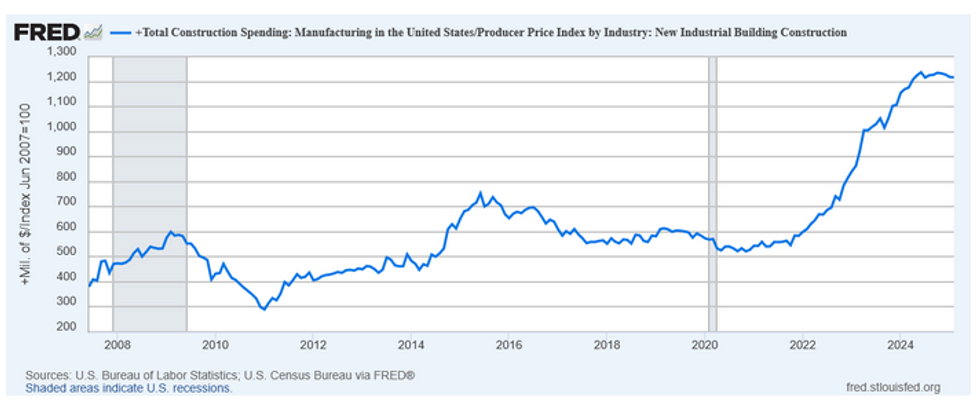Donald Trump promised that he would lower prices on day one of his new term in office. He also promised to end the war in Ukraine on his first day. Neither of those quite panned out. But it looks like he might accomplish something not on his list, he quickly ended the manufacturing boom he inherited from President Biden.
You may not know of this boom because it didn’t get much attention during the campaign. This was partly because it was in construction not employment.
Biden’s record on employment in manufacturing was pretty good given the reality of the pandemic, but it did not surge. His recovery package quickly brought back the 600,000 manufacturing jobs lost in the pandemic. We had gotten back those jobs by the spring of 2022. But then growth had trailed off and by the end of his term, manufacturing employment was only slightly higher than it had been at its pre-pandemic peak.
But factory construction tells a very different story. There was an unprecedented boom in factory construction in the Biden administration, as shown below.

Real construction more than doubled over the course of his administration. (These data are adjusted for inflation.) And this was all Biden’s doing. Construction of factories was edging downward under Trump, even before the pandemic.
It should not be a surprise that factory construction rose under Biden, this was by design. His three major bills on long-term spending, the infrastructure bill, the CHIPS Act, and the Inflation Reduction Act (IRA), were all designed to boost segments of manufacturing in the United States. Specifically, the goals were to increase production of high-end computer chips, electric vehicles, batteries, solar panels, and other items needed for a green transition.
And these bills worked to a remarkable extent. This boom in factory construction has not yet led to an employment boom in manufacturing, in part because factories are mostly still under construction. But we also are not likely to see a huge employment boom for the simple reason that productivity growth means that factories don’t employ as many people as they used to.
Even large factories tend to employ in the hundreds, not the thousands or occasionally tens of thousands in the factories of half a century ago. Many of the hundreds of people employed in these new factories will be getting good paying jobs, especially if they are union jobs, but it is hard to make much of a dent in a labor force of 160 million workers. The idea that we ever again see a large share of the workforce employed in manufacturing is an illusion that lives only in Donald Trump’s head.
But the good news on manufacturing is in the rear-view mirror. Thanks to Trump’s tariffs threats and his deliberate attacks on President Biden’s programs, it looks like manufacturing employment will be headed downward for the immediate future.
At this point in the administration, we have limited data, but there are a few things we can say with confidence. Factory construction in February was already down 1.4 percent from its October level. Factory construction doesn’t just stop on a dime. It can take two or three years to build a factory. This means factory construction is likely to stay relatively high through 2025, but the direction is clearly downward. Employment is also more likely to go down than up in the year ahead.
This is confirmed by a series of surveys of manufacturers across the country. The New York district Federal Reserve Bank survey of manufacturers found that its expectations index had fallen to a level that was lower than either the trough of the pandemic or the Great Recession. The Philadelphia Fed’s index also plunged, although not to the same extent. Noteworthy in this survey was a sharp decline in expected employment. The ISM nationwide survey of manufacturers also showed expectations of future employment falling sharply.
It seems Trump’s actual and threatened tariffs are the biggest factor here. Our manufacturing is thoroughly integrated with the rest of the world now. If companies have to pay high taxes on the material and components they import from our trading partners, it’s an increase in their costs. They will either have to pass this on in higher prices or eat in the form of lower profits. Either way, it is likely to dampen production.
The uncertainty on future tariff levels is even more harmful. Companies have little basis for deciding on expansion plans if they don’t know whether imports from major trading partners will be taxed at rates of over 100 percent or near zero, as was the case before Trump took office. The rational thing for managers to do in this situation is to delay investment until the picture becomes clearer.
We also know that spending on durable goods soared after Trump’s election, as people attempted to beat the tariffs. Durable goods consumption grew at a 12.4 percent annual rate in the fourth quarter of last year, driven entirely by purchases in November and December, following the election. This pretty much guarantees a slump this year, since people who bought a car in December will not buy another one this summer.
The overall picture for manufacturing does not look very bright right now, especially with Trump doing everything he can to undermine the spending and subsidies that are still to go out the door from the IRA, the infrastructure bill, and CHIPS act. Donald Trump may not be able to claim he ended the Ukraine war or lowered prices on his first day in office, but he does have a credible claim that he brought a quick end to the factory construction boom he inherited from Joe Biden.


